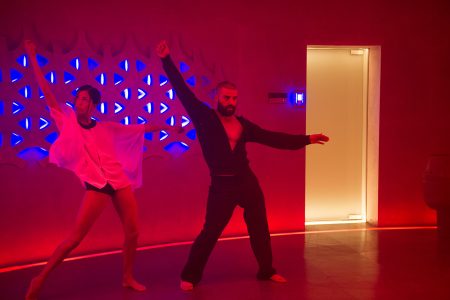Don’t Worry Darling is one of those movies that everyone already has an opinion of even before seeing it, due to the countless controversies surrounding it. But between all the drama and debate of whether Harry Styles spat on Chris Pine, whether he can act at all and whether Florence Pugh hates director Olivia Wilde, one thing that hasn’t really been mentioned is how important dance is in this film.

article
Dance+: Don’t Worry Darling

The idea that everything that is beautiful in dance can be equally sinister and terrifying has been around since long before Black Swan. Wilde plays with this dichotomy throughout the movie – and she even hired Black Swan’s cinematographer Matthew Libatique to visually support her game. Young married couple Alice (Florence Pugh) and Jack (Harry Styles) live in an idyllic 1950s-looking company town called Victory, where the men work on a mysterious project under the leadership of company founder Frank, while the women spend their days in full Stepford Wives mode at home. When they are not polishing the house or themselves, they take ballet lessons from Frank’s wife, Shelley (Gemma Chan). In the first ballet class scene – which despite Shelley’s kind façade, has the aura of the strictest Russian ballet academies – we see the housewives practising at the barre and later arranging themselves into beautiful and graceful formations.
‘Remember ladies,’ says Shelley during class, ‘there is beauty in control. There is grace in symmetry. We move as one.’
In fact, in Victory, everything seems to be about control. But it is also at the ballet class where an increasingly suspicious Alice realises something is seriously wrong with the town and its residents. In a scene that very directly references Black Swan, Alice’s reflection starts to live its own life, and suddenly instead of herself she sees another housewife, Margaret, an outcast from the community because of her strange behaviour, banging her head against the mirror and hurting herself. After Alice’s desperate screams, the vision fades, and it turns out that no one else in the class has seen what she saw.
But now Alice keeps having visions throughout the day. In images that look like flashbacks or dreams, she sees platinum blonde girls who look and dance like they are straight out of a Busby Berkeley movie: a recurring moment is where the girls lie on the floor in a big circle and fold their legs from one side to the other in unison. The main appeals of Berkeley’s most famous dance scenes are the synchronised movement and kaleidoscopic patterns, which are fun and pleasing to the eye – but these mass choreographies can also awake an unsettling feeling of higher control. No wonder that, according to the British Film Institute, Joseph Goebbels was a fan of Berkeley. There is beauty in control, grace in symmetry – remember?
https://www.youtube.com/watch?v=Dg5tcwZTxIs
The tension that Alice experiences – and with her, the spectator – reaches its peak at a party organised by Frank and Shelley. As a surprise to entertain the guests, Shelley introduces burlesque dancer Dita Von Teese, who presents her usual glamorous spectacle, including a sexy and soapy bath in a champagne glass. But even this feather-light entertainment gets chilly as we watch Alice feeling more and more trapped and getting very close to a panic attack. An evil flash of the eye from Dita to Alice is all it takes to twist the atmosphere of that charming dance and send a shiver down our spines.
Then finally it’s Harry Styles’ turn to dance. After Frank calls Jack on the stage and rewards him with a promotion, he asks him to dance – but it sounds more like an order or a threat than a request. Jack breaks into a tap routine, but he has none of the lightness or charm of a tap dancer – if anything, he looks like he’s dancing for his life. ‘Let’s make him spin, shall we?’ shouts Frank, who animates the cheering audience like a cult leader, and seems to somehow have Jack’s every move under control without actually instructing him. The camera cuts back and forth between the stage and the bathroom where, meanwhile, Alice has a breakdown. While her husband perfectly plays the part of the promising young Victory citizen, she tries to explain to fellow housewife Bunny (played by Olivia Wilde) how nothing is what it seems in this town of illusions. But by the time Jack is finally allowed to finish his dance near complete exhaustion, Alice realises she is entirely alone.
Towards the end, when everything is revealed, it turns out that those Busby Berkeley-like scenes were in fact used for vicious purposes. You can debate many aspects of Don’t Worry Darling, but you can’t deny its smart and well-thought symbolism, and dance is central to it.





